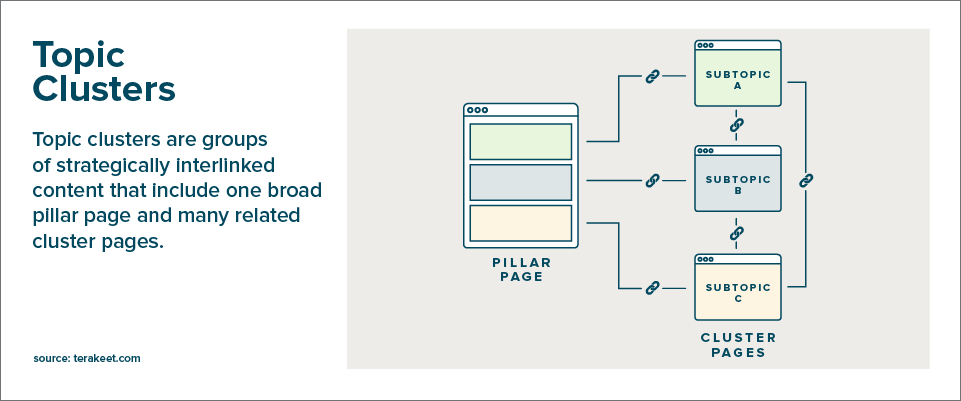
B2B SEO Strategy for Marketing Executives (2022 Guide)
Feb 21, 2020|Read time: 20 min.
Key Points
- B2B SEO targets multiple decision makers and requires a unique keyword strategy that can target each decision maker at each stage of the funnel.
- Gated material, spaghetti code, PDFs, splash pages, pop-ups and live chats create unique SEO challenges for B2Bs.
- Improve your B2B SEO by delivering free tools and resources, conducting original research, publishing topic clusters and purchasing existing websites.
- Take your B2B SEO results even further by running co-marketing campaigns and collaborating with publishers and influencers.
- Create a highly targeted and personalized link-building strategy.
Search engine optimization (SEO) evolves at a staggering pace — especially for B2B companies. Yes, time-tested strategies like keyword research are still critical. But you need more creative B2B SEO strategies in order to climb the rankings and stay on top. You can no longer assume that a well-optimized site and a simple blog strategy is enough.
How can you take things to a new level? Engage in bigger, SEO-focused business growth strategies and you’ll achieve remarkable results.
Does it involve more work? Yes, but . Plus, the barrier to entry is higher. That means your competitors will hesitate making the investment and commitment needed to keep up.
B2B SEO is different
The purchase process for B2B is longer and more complex than B2C. That means your B2B SEO program must be customized for B2B in order to maximize your organic search results. Trying to follow B2C practices in B2B SEO will limit what you can achieve.
The following is a summary of several key differences for B2B SEO vs. B2C. Learning to capitalize on these differences will help you to improve your SEO performance significantly.
Targeting multiple B2B buyers in the organization
One of the biggest differences between B2C and B2B SEO is the number of potential customers who are involved in the buying process. B2C SEO targets one customer at a time, taking them through a complete journey that ends (hopefully) with a transaction.
For B2B companies, a single transaction might require approval from several decision makers. These players could include the economic buyer, the user buyer, the technical buyer, C-suite decision makers and the team that will be using your product or service the most.
If you sell HR software, for example, the purchase decision might involve the C-Suite, a representative from IT (who will be integrating the software with the company’s current system), the head of HR and department managers who will be using the software. And if the company’s employees will be using the software too, you can bet they’ll want to hear some form of employee feedback before pulling the trigger.
That means your B2B website strategy needs content that addresses:
- C-Suite’s questions about the bottom line
- IT team’s technical and integration questions
- HR’s efficiency-related questions and the average employee’s usability questions.
An integrated marketing strategy ensures that each customer reaches the same destination regardless of their individual priorities.
Value of Organic Search White Paper
See how an investment in organic search delivers ROI that compounds over time.
B2B SEO keyword strategy
Your keyword research strategy will reflect all of these different decision-makers and what they’re searching for. A B2B SEO specialist like Terakeet can help you find the pain points or specific needs of each one.
A CEO might want software that drives revenue, which means you can focus on keywords that emphasize SEO ROI. An HR director will want to boost efficiency and employee happiness. And a technical buyer will look for software that integrates with the ERP system their company is using.
All of them, average employee included, will want to know how the software makes their job easier. They’ll also all want to know why your software is better than their current system. That means you can target comparative search queries related to your competitors. And if they don’t like their current system, they’re searching for a replacement or alternative, which gives you keyword opportunities like “[Popular Competitor] alternative.”
There’s more. Each B2B buyer will be at one of three stages in the purchase funnel: Awareness, Consideration, Decision. Each stage offers its own set of long-tail keywords. Some are broad and interest-oriented (Awareness), while others are tightly focused on the brand (Decision). For example, an HR director in the Awareness phase might just be looking for tips and articles about employee happiness. An HR director in the Decision phase, on the other hand, is looking for reviews of your product.
Given the specific nature of B2B products and software, your strategy will likely rely on lower-volume keywords than B2C companies. But the lower competition and lack of SEO saturation for B2B companies can lead to huge payoff on clear-cut keyword opportunities.
Technical SEO for B2B companies
Just like with B2C SEO, technical SEO strategies across B2B websites are so site-specific that they almost can’t be generalized. Perform the same style of technical audit you’d perform on any website. Start with a site crawl and then check the box on the usual suspects:
- Page load speed
- Coding
- URL protocols
- Site navigation
- Indexing
- Canonical tags
- Security
- Meta descriptions
Look for anything that can impact a crawler’s ability to move through your site quickly and understand your content.
Business to business websites often contain specific technical issues. So it’s best to work with an experienced B2B SEO agency if you don’t know what to look for. That said, here are a few things to watch out for:
Common technical SEO issues for B2B sites
Resources or priority pages that are housed on subdomains
Because the B2B world is so highly segmented, moving different types of information to different subdomains is a common solution. Double check that each subdomain follows the same B2B SEO best practices as your main domain. Sometimes SEO teams will focus all of their attention on the main domain, while certain subdomains work under different guidance and rules, leaving you vulnerable to subdomains that needlessly perform poorly in the search engine results pages (SERPs).
Gated material that shouldn’t be gated
It’s common for B2B websites to have login-only sections for their customers that can contain access to wholesale products, exclusive tools and forums, and personalized services. Unfortunately, these can also contain resources and articles that can benefit your entire prospective search audience!
Identify all of the gated or unindexed portions of your site and make sure that gating the information is the best strategy for the company. The reverse of this issue, ungated material that should be gated, can have serious consequences as well.
Spaghetti code
There’s a common assumption that B2B companies have clunky, unattractive websites while B2C websites are design- and user-friendly. This is no longer the correct assumption to make. B2B companies may have had the first ecommerce sites on the web (really!). But the sites were designed for utility, not b2b marketing.
Over time the game has changed significantly.
But don’t let an attractive B2B website fool you: if that company has a long shelf-life, it may contain some remnants of the past in its code.
This style of “spaghetti code” happens over time as different systems and elements are worked into the website. And it can be the silent killer of your SEO strategy. Redirect loops, old scripts, slow WordPress plugins, weird tags, shortcut solutions and junk code can impact crawlability, speed and performance. Using crawling and site speed tools, work with your developer to find these instances and fix them.
Well-intentioned splash pages, live chats and pop-ups
B2B companies are a little more likely than B2C companies to rely on these for qualified lead generation or closing sales. And they should! But the wrong ones or poor integration can cause bugs that impact crawlability. Sometimes splash pages even block the pages they’re on from receiving any authority at all. Pop into Google Search Console and Google Analytics while cross-referencing your underlying web page code. Give everything a sniff test, checking for outliers that may indicate a blocked page or a script that’s causing each visit to register twice.
Off-page SEO for B2B marketing
The decision journey is often longer for B2B companies. And this means there will be different types (and many more types) of opportunities for off-page SEO at the various stages of the funnel.
In order to support off-page SEO sufficiently, your content production plan will need to support your prospects over multiple months (and sometimes longer than a year) throughout the customer journey. You should also look at industry-specific platforms and sites, along with professional social networks such as LinkedIn. These communities offer opportunities to not only connect with your audience and buyer personas, but to do so in a way that generates organic backlinks pointing at your site.
We go into much more depth in examining off-page SEO strategies below, with each tactic a strong performer for B2B SEO marketing specifically.
B2B SEO best practices
Let’s take a look at some powerful SEO strategies you can incorporate to grow market share.
Match search intent through the funnel
Imagine you’re on the lookout for a new project management platform. Right now, you’re just trying to compare platforms, so you Google “best SEO project management platforms.” You’re probably hoping to find ratings and comparisons from third party sites, right? If, instead, you found blog posts from individual platforms on best project management practices, you’d be pretty disappointed. You’re not looking for project management tips.
On the flip side, let’s say you’ve done all your research on all the platforms available. Review sites have led you to a specific platform you’re ready to learn more about: Asana. So you Google “Asana features.” You’re ready for an in-depth look at all Asana has to offer. So, if Asana’s blog post, Diversity and Inclusion at Asana, showed up in the SERPs, you’d be scratching your head. You’re looking for features, after all. Why would Asana optimize this blog for the keyword “Asana features”?
Answer: they wouldn’t, because that blog post does not match the search intent of “Asana features.”
The decision journey is longer for B2B companies, so it’s important to consider user intent SEO as you create content for users at every stage of the conversion funnel.
Think ToFu MoFu BoFu
At the top of the funnel, look for content and partnership opportunities to promote broader, more educational topics that satisfy research intent. In the middle of the funnel, brainstorm deeper topics related to your types of products and services as well as more complex solutions your audience is seeking. Lower, at the bottom of the funnel, your audience is trying to make a final decision. Explore opportunities that would compel them to action in making a final decision. This can take the form of ROI calculators, product comparisons and proof of concept information.
Find out more about funnels here: What the Heck is ToFu, MoFu, BoFu?
Content Strategy Playbook
The Fortune 500 CMO’s guide to content strategy.
Don’t be boring
What’s the most destructive myth about B2B SEO? It’s the assumption that B2B content marketing is boring. This should never be true! And lucky for you, it’s demonstrably…not. The subject matter for B2B content may not be as universally interesting as some B2C subject matter. But the people who should care will find the subject matter interesting. That doesn’t mean they’ll find every approach to the topic interesting, though. So don’t drop the ball with dry content driven by an uncreative strategy.
In fact, you’ll probably have to work twice as hard to make your content interesting. A B2C customer might have a natural affinity for fashion. But an HR director won’t necessarily have the same passion for HR software. So you’ll have to dig deeper to produce the content that will keep them interested. Use storytelling to evoke emotions and produce genuinely useful content that addresses different audience needs before they purchase your product.
Create free tools, templates and resources
Want to drive a large number of backlinks? Create a better user experience with free assets that your target audience would find not only useful, but ridiculously shareable.
More specifically, free tools, templates or resources.
For example, Campaign Monitor created a library of free email templates for businesses to use.
The page currently ranks #2 for the search term “free email templates” (down from #1, a position it held for months) and it has attracted over 330 backlinks. That’s some serious mileage for a single content push.
CoSchedule built a headline analyzer that has generated approximately 23,800 backlinks. It has also generated five figures worth of social interactions.
Tableau Software offers a free data visualization tool. By launching this tool, Tableau has secured roughly 37,200 backlinks for its related US web pages and more than 2.2 million backlinks globally. Not too shabby!
People love free stuff, especially if it’s valuable and helps them to get their job done better and more efficiently. If you create a free, valuable tool or template like our SEO checklist, people will share it, which can create a potential avalanche of incoming links and organic traffic.
Conduct original research
How many times have you read an article that starts with the phrase, “A new study by…”? Sometimes, these studies reveal that something we previously loved to eat is actually terrible for us and causes premature death. But that’s beside the point…
The point here is that new studies and research often generate buzz. Sometimes generate a lot of buzz. People talk about the study results with colleagues, news sites link to them and bloggers cite them.
How much buzz? Well, according to the aptly-named BuzzSumo, original research is their most popular content. BuzzSumo’s content strategy is formidable, attracting some of the world’s biggest brands and securing them as customers. So, their most popular content has some serious organic heft.
Ahrefs published a study on backlink acquisition. Within a mere two weeks they’d attracted approximately 200 backlinks and over 570 social shares.
An organization that trains nurses to become legal nurse consultants for law firms published a proprietary study on nurses and stress. One publicity opportunity led to another. And the owner of the business wound up appearing on national TV five times over the course of the year following the release of the study.
Original research takes effort. But if you publicize the results through special reports, blog posts, SlideShares, infographics, outreach campaigns and PR, the benefits can be substantial.
The moral of the story? Original research is an irresistible magnet for publicity and natural backlinks. And that’s an easy way to boost your off-page SEO.
Use SEO topic clusters and pillar pages
Ever since the introduction of Google Hummingbird, targeting topics (as opposed to individual keywords) has become increasingly important for businesses. Google doesn’t just focus on keywords. It also looks for context and considers how effectively a brand addresses a broader topic as a whole. This enables Google to see through the websites that are not true topic authorities.
That’s why it’s crucial to develop a content strategy centered on SEO, rather than attempting to layer it on as an afterthought.
One particularly effective way to generate organic traffic at the topic level is to create SEO topic clusters on your website. A topic cluster is a hub-and-spoke content model, in which there is a collection of pages anchored around a pillar page. The pillar page speaks broadly to an overarching subject, while the sub-pages go into much more depth about specific areas of the topic.
The pillar page links to the sub-pages and vice versa, like this:

Topic clusters provide Google with a clear understanding of how all the pages are linked together and speak to the topic as a whole.
Create in-depth content for B2B SEO
There’s a common misconception that all searchers prefer short, surface-level blog posts. While that may be true in some cases, most searchers want to extract value from the content they consume. That’s why a key ingredient to becoming an industry authority is the creation of helpful, in-depth content.
That’s not to say that everything you publish should be a wikipedia entry. You’ll need to analyze the competition to determine the appropriate length for each topic and best format. You’ll also need to target the right audience. Check out these buyer persona examples for more insights!
Google the target keywords for your content and spy on what appears in the SERPs for those keywords. What sort of content is it? How long? What sort of tools and resources does it offer? What problems does it solve? And what intent does it fulfill?
Want to outrank the competition? Then your B2B content marketing must be better than the top results.
If you choose to stray from the format you see in the SERPs, just make sure you’re improving it by making it more valuable for the individual consuming the content.
What do we mean by in-depth content?
Again, that varies according to persona, topic and industry. In certain cases it might mean a 3,000-word post, and in other cases a 5,000-word post. Or depth might mean a 20-minute video or a survey-based report.
But as a general rule, begin with the assumption that in-depth content isn’t something a newcomer to your industry could write. For example, Terakeet produced the following in-depth pieces:
- Enterprise SEO – Why Marketers Need Enterprise Search Optimization
- What is Digital Marketing? Everything You Need to Win
Organic search rankings are competitive. If your competitors are ahead of you in the SERPs, they’re pushing you down the page and reducing your click-through rate. If you overtake them, you’ll push them down the rankings. The result is not only higher traffic for you, but lower traffic for them. It’s a double win. To achieve this for high priority topics, though, your content needs to be in-depth and better than the competition.
Give them all the content, facts, pictures, tools and expert guidance they’re looking for. And allow for all the hours and resources that a substantial piece of content takes to get off the ground.
Get visual and interactive
A big part of providing useful content is providing it in the format that best serves the content. You can enhance your written content by adding graphics, charts, visual or video walk-throughs and anything that will make the content more accessible, moving or interesting. From high-quality photography that tells the story of your customers to infographics featuring your original research, visuals are a great way to drive key information home for all of your stakeholders.
Plus, visual content helps your site visitors retain the information. When consuming text, the typical person remembers only 10% of the information 72 hours later. Add visuals, and they retain 65%.
Your visuals don’t always have to accompany written content, either. They can be the content itself. If you conduct webinars, you can share the recording in video format, the slides via SlideShare or repurpose them for a slideshow-style blog post. Infographics, data visualizations, interactive tools, surveys, podcasts and videos can all stand alone without written content. That said, if you do end up with content that’s mostly visual, pay attention to these video SEO best practices. Find a way to transcribe key information so that the search engines can crawl it and so that visually-impaired users can still access the content.
For inspiration, make sure to check out our post about the importance of visual content marketing. The strategies and examples outlined in the post are just as B2B-ready as they are B2C.
Purchase existing websites
Yes, this approach takes money. But it could also greatly accelerate your path to higher rankings on targeted terms.
One of the key reasons for PetSmart’s $3.35 billion acquisition of the online pet goods retailer Chewy.com was the strong organic search visibility of the online pet retailer. On the B2B side of things, the Fortune 500 company Arrow Electronics bought up a series of publications in the electronics component parts industry. This included a $23.5 million acquisition of the entire electronics media portfolio of UBM, including EE Times, EDN and DataSheets.com.
Over a two-year period, Arrow established itself as the largest publisher in the industry. Quite a change for an 80-year-old company in an analog industry. But this is evidence of the power of such a content and SEO approach.
There are various benefits to purchasing an existing website, blog, or content hub, including inheriting the existing:
- Organic traffic
- Organic rankings
- Backlinks to the site
- Content
- Access to a new or niche audience
- Associated social accounts (if this is part of the acquisition)
You can then also add highly relevant links to your main website. Don’t be spammy, of course. But adding a few truly relevant links in contextually appropriate spots would be beneficial to your SEO results.

Events
Hosting events is a highly effective marketing vehicle for B2B companies. And it can contribute to your organic search results when done right. Events blend old, tried-and-true B2B relationship-building tactics with the amplifying power of social media, word of mouth and link building. And when these merge, the results can be spectacular.
Events in and of themselves provide you with plenty of opportunities for content creation. As the content can be highly educational in nature (or intriguing in nature if purely promotional), it’s a good candidate for social sharing and backlinks.
To take your event results to a new level, recruit your speakers to be an army of promoters. This broadens your reach, increasing the likelihood of further sharing and linking. And don’t leave it to chance. Define expectations for your speakers. Provide them with a promotional kit to make it easy for them to get the word out. Include videos, graphics, messaging, etc.
Taking it a step further, have your speakers contribute blog content leading up to the event. You can also host a series of “teaser webinars” in which you interview a speaker or set of speakers leading up to the event. This builds your library of content and promotes the event at the same time. A double win!
In the case that your event is large enough, invite the press and encourage them to cover it in their publications. The resulting press would be a huge win for your B2B search engine optimization strategy. Not only will you earn positive press coverage but also high-quality backlinks from reputable publishers.
Collaborate with publishers
Empowering others to market your brand is pure digital marketing gold. Influencers have the audience and credibility to help you get the word out. But too often B2B companies take a myopic approach to influencer marketing. They reach out to only a few online publishers, and it’s largely hit or miss and highly transactional.
Here’s what many brands miss. Influencers want something exciting. Something that will thrill their audience. Lead generation landing pages won’t get too much enthusiasm from influencers.
To get real results, bring something exciting to the table. Brainstorm a creative topic for them to create new content, share proprietary research, or offer them something exclusive.
Terakeet took this exact approach when working with a popular business software company. Leveraging the existing online marketing strategy, we reached out to business bloggers asking them to write about their favorite business tools and why they’re critical.
We sent more than 3,500 targeted emails to online publishers which resulted in 226 posts on unique domains. The posts featured authentic content created by the publishers and included natural backlinks to key pages on the software company’s website.
Want to really knock this strategy out of the park?
Rather than approach just a few online publishers, connect with thousands. At Terakeet, we leverage Chorus, a proprietary database of more than 9 million domains to find the perfect set of publishers, partners and micro-influencers for our clients.
The sheer power of unleashing hundreds or thousands of influencers for a brand can deliver staggeringly awesome B2B SEO results.
We said think BIG, right?
Run co-marketing campaigns
Another effective B2B SEO strategy is to run joint content marketing campaigns with strategic partners or complementary organizations. This is one of those “hidden in plain sight” strategies that’s powerful and accessible for nearly every B2B company. It’s likely that you already have the partnerships and/or network to leverage.
Are you are already producing white papers, webinars, SlideShares, blog posts, videos and events? Then, why not join forces with other organizations to share insights and discover new content ideas.
For example, when Hubspot and Chatfuel teamed up to help businesses implement chatbots with the joint publication of The Beginner’s Guide to Building Your First Chatbot, they were able to leverage the expertise of each company to produce a fun, unique piece of content. This allowed both companies to introduce themselves to a new (but not out-of-the-ballpark) audience and increase their reach with a shareable asset.
Follow suit by brainstorming where you and your partners overlap in expertise/audience and what you can contribute to each other. If you partner on a webinar, produce a whitepaper based on the webinar content and promote both through both organizations’ websites, blog, email and social channels. If you engage in a joint event, market it to both databases.
It’s an easy way to double your reach, while also getting in front of completely new audience members. Plus, it enables you to write engaging content that generates new traffic, sharing, opt-ins and backlinks.
Check out these incredible content marketing examples with massive business impact.
Link building
Many smaller B2B SEO services offer stand-alone link building packages. But before you sign the contract, make sure you know what those agencies provide. They often prioritize quantity over quality, and that won’t move the needle.
An Enterprise SEO company like Terakeet, on the other hand, understands that higher quality links are far more valuable.
Follow the relationship-first ethos of the B2B industry and you’ll discover plenty of link building opportunities from within your own network. Industry blogs, publications, podcasts, associations, partners and friends-of-friends within your industry network. These are all great places to start your blogger outreach efforts.
Once you’ve exhausted that option, target other high-profile publications. Put extra effort into researching the publication, finding the right content fit and the right ask. If you’re working with a B2B SEO company, make sure they tailor their emails to the publication to make it clear that they really know the industry. It’s also helpful to suggest topics that publishers have yet to cover. Build up thought leadership by guest authoring posts or being interviewed.
You can even offer to write a monthly column, building familiarity, consistency and brand recognition.
Target the right audience
Remember all those key decision-makers? Find the resources they read and trust. Hold regular meetings with the corresponding decision makers at your own company. Ask them what they’re excited to teach, or what they want to learn more about.
For example, if you sell HR software, then your audience includes HR Directors. So meet with your own HR director, to learn what the HR world cares about. Or maybe your director is a disability benefits pro who can author a comprehensive guide on reasonable accommodations. The guide can also soft-sell your software by pointing out that transparent timekeeping and workflow systems can help people stay on top of sick days or take care of certain responsibilities from home.
Combining a highly targeted and personalized B2B search strategy with SEO technology like Chorus increases your website traffic and improves your conversion rates.
Aim for the fences, flex your creative muscles and be bold and daring with your B2B SEO strategies! Create tools, purchase domains, or unleash hundreds of influencers for a campaign who will talk about your products and services. That’s anything but boring!




